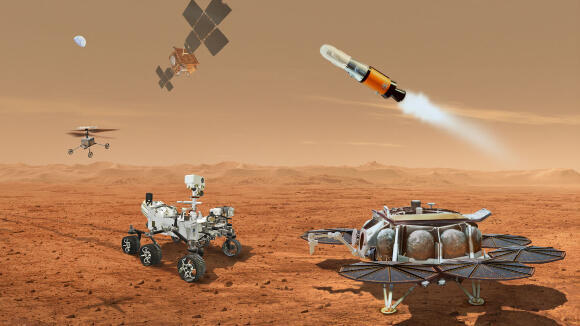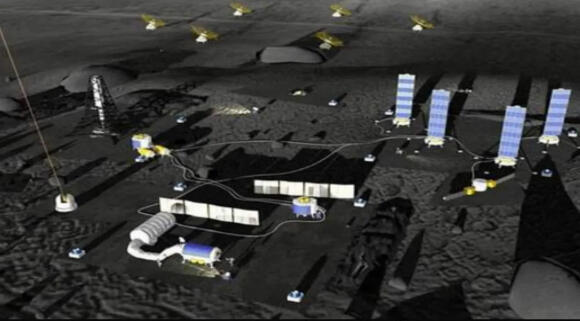China is finalizing its plans for a manned moon landing by the end of the decade. The Deputy Chief Planner of the China Manned Space Agency (CMSA), Zhang Haiyan (Zhang), unveiled some of the details of this plan at an international conference held last week in Wuhan. According to the plan, a spacecraft carrying astronauts and a lunar lander will be launched separately on Long March 10 rockets, currently still under development.
Read more:
The two components will rendezvous in a lunar orbit, where two astronauts will transfer to the lander, descend to the moon's surface, and spend several hours there. They will set up scientific experiments, collect soil samples, then relaunch the lander, return to the spacecraft, and return to Earth. The launch vehicle tests are scheduled for 2027.
2 View gallery


The high costs cast doubts on the mission. Components of the Mars sample return mission
(Illustration: NASA/JPL-Caltech)
This week, China issued a call for proposals for experiments to be conducted on its lunar lander. This opportunity allows research institutions and private entities to propose experiments and research in a variety of fields, such as physics, geology, space observations, and the exploitation of natural resources available on the moon.
China's planned manned mission isn't a standalone event; it serves as a stepping stone toward establishing a manned base on the moon during the next decade. Prior to this, Beijing intends to land a series of unmanned instruments on the moon to test new technologies. Among these initiatives is a planned landing in the moon's southern polar region, which is believed to harbor frozen water, thus drawing interest from several space agencies.
Mars sample collection in jeopardy
The United States Space Agency, NASA, is planning to launch an unmanned mission to Mars by the end of the decade, which will, for the first time, bring soil samples from the red planet back to Earth for analysis. The mission, known as MSR (Mars Sample Return), is a collaboration with the European Space Agency (ESA) and aims to retrieve samples collected by the Mars Perseverance Rover over the past two years, stored in specialized metal tubes and deposited at potential collection points. The rover is equipped with 43 storage containers, and to date, 18 of them have been filled with soil samples.
The future of the mission now seems uncertain after the Senate Appropriations Committee in Washington D.C. declined to grant NASA the funding it requested. The committee expressed concerns about the feasibility of the plan and the potential for significant deviations from the ambitious timeline and budget. According to a report published on The Hill website, the space agency sought to allocate a budget of 939 million dollars for the program in 2024. However, a subcommittee of the Appropriations Committee, also responsible for scientific body budgeting, agreed to allocate only 300 million dollars – less than a third of the requested sum. Furthermore, the committee threatened to withhold even this amount if NASA cannot demonstrate that it can carry out the mission without exceeding the overall planned budget, currently estimated at $5.3 billion.
2 View gallery


An active research station. An artist's impression of the future Chinese lunar base in the 2030s
(Photo: CNSA/CLEP)
The likelihood that NASA will be able to carry out the mission as per the planned timeline, with a launch by 2028, seems almost non-existent. The chance of staying within the budget appears even slimmer. Complex missions tend to overrun the planned costs, particularly so in governmental bodies. According to NASA sources, the current estimated cost of the mission is around $9 billion, a figure that does not include important components such as launch costs, the mission's regular operational costs over an approximate five-year period, or the establishment of a laboratory to receive the samples from Mars and study them.
If the committee indeed denies funding for the sample collection mission, the provisional amount allocated to it conditionally for next year, $300 million, is expected to be reallocated to the Artemis program, designed to land humans on the moon starting from 2026.
Pioneering space tourism flight
About a month after resuming tourist flights to the edge of space, Virgin Galactic has announced that the subsequent flight is scheduled for August 10. The passengers on this flight will include Jon Goodwin, an 80-year-old British adventurer who, despite being diagnosed with Parkinson's disease nine years ago, remains undeterred and is committed to leading a full life. Although Goodwin will not be the first individual with Parkinson's to journey into space, he is set to be the first Olympic athlete to do so, having represented Britain in the first-ever canoe slalom competition to be held at the Olympics, during the 1972 Munich Games.
Accompanying him will be a mother-daughter duo from Antigua and Barbuda in the Caribbean - 18-year-old Anastasia Mayers and her mother, Kisha Schahaff, who is married to an Israeli. This pair will make history as the first mother-daughter duo in space and also as the inaugural representatives from the Caribbean islands. Both of them won a space flight to the edge of space in a lottery held by Virgin Galactic two years ago. Also joining them in the passenger compartment will be the company's lead astronaut instructor, Beth Moses.
James Webb's ancient diamonds
Using the James Webb Space Telescope, researchers have identified, for the first time, the chemical signature of carbon-rich dust grains in remote galaxies. These galaxies are situated so far away that we observe them as they were less than a billion years after the Big Bang - that is, during the first billion years of cosmic time. Previously, this carbon signature was only found in younger galaxies, where these carbon and hydrogen atoms formed ring-shaped molecular structures. The researchers propose that such complex molecules had not yet been formed at this early stage of the universe, leading them to speculate they have detected simpler forms of carbon - perhaps small crystals of graphite or tiny diamonds, formed in the cores of stars or during their supernova explosions.
The discovery was made possible primarily due to the robust capabilities of the space telescope, particularly its infrared spectrograph. This device enables scientists to observe galaxies that are moving away from us at high speed, consequently shifting the light they emit toward the red and infrared spectrum. The faster a galaxy is moving away from us, the farther away it is, and thus researchers can determine the distance to the galaxy based on its redshift. The detailed findings have been published in the scientific journal, Nature.
“This discovery implies that infant galaxies in the early Universe developed much faster than we ever anticipated," said co-author Renske Smit from Liverpool John Moores University's Astrophysics Research Institute. “Webb shows us a complexity of the earliest birthplaces of stars (and planets) that models are yet to explain.“
- Content distributed by the Davidson Institute of Science Education

